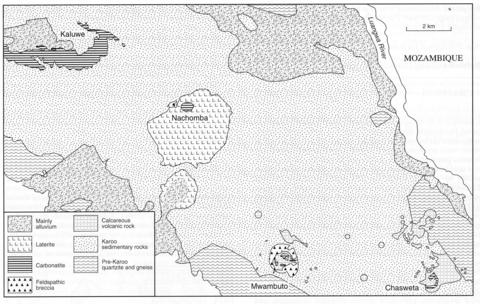stripes
The Mwambuto Hills form a ring, approximately 5 km in diameter, of domed metasomatised Karoo mudstones, inside which is a ring of feldspathic breccias. The 1.5 km diameter core of the complex forms a depression and is composed of volcanic and intrusive carbonatites. There are a number of small satellite vents around the periphery of the hills which are filled with carbonatitic pyroclastic rocks, while to the northeast is an extensive area of pyroclastics which Bailey (1960 and 1966) considers to be a remnant of material extruded from the Mwambuto volcano. The feldspathic breccias are essentially orthoclase rocks with a veinlet network filled with comminuted feldspar and limonite, the whole rock being cut by later veinlets of silica and iron oxides, sometimes with a little barite. These rocks generally have >10% K2O. They pass inwards through a mixed zone into intrusive carbonatites that are concentrically and vertically banded. The predominant carbonatite is a fine-grained ankeritic rock, with varying degrees of silicification, which is interbanded with less voluminous sovite. Associated with the silicification are thin layers rich in martite, apatite and barite, while accessory pyrochlore, bastnasite, monazite and fluorite are also found. The pyroclastic rocks, which cut the intrusive carbonatite and occupy more than half of the vent, range from very coarse agglomerates to tuffs. The agglomerates consist of fragments of carbonatite and associated rocks with some Karoo and pre-Karoo rocks, in a tuffaceous carbonate matrix of dolomitic or ankeritic composition. A few patches of agglomerate contain abundant fragments and flakes of phlogopite. The tuffs are generally bedded with graded and cross-bedding sometimes apparent. A few thin cone sheets of carbonatite up to 0.5 m thick cut the volcanics in the northeastern sector of the vent, and Bailey (1960 and 1966) considers that they may be altered alnoite or solvsbergite dykes.
BAILEY, D.K. 1960. Carbonatites of the Rufunsa Valley, Feira District. Bulletin, Geological Survey of Northern Rhodesia, 5: 1-92.BAILEY, D.K. 1966. Carbonatite volcanoes and shallow intrusions in Zambia. In O.F. Tuttle and J.Gittins (eds) Carbonatites. 127-54. John Wiley, New York.

